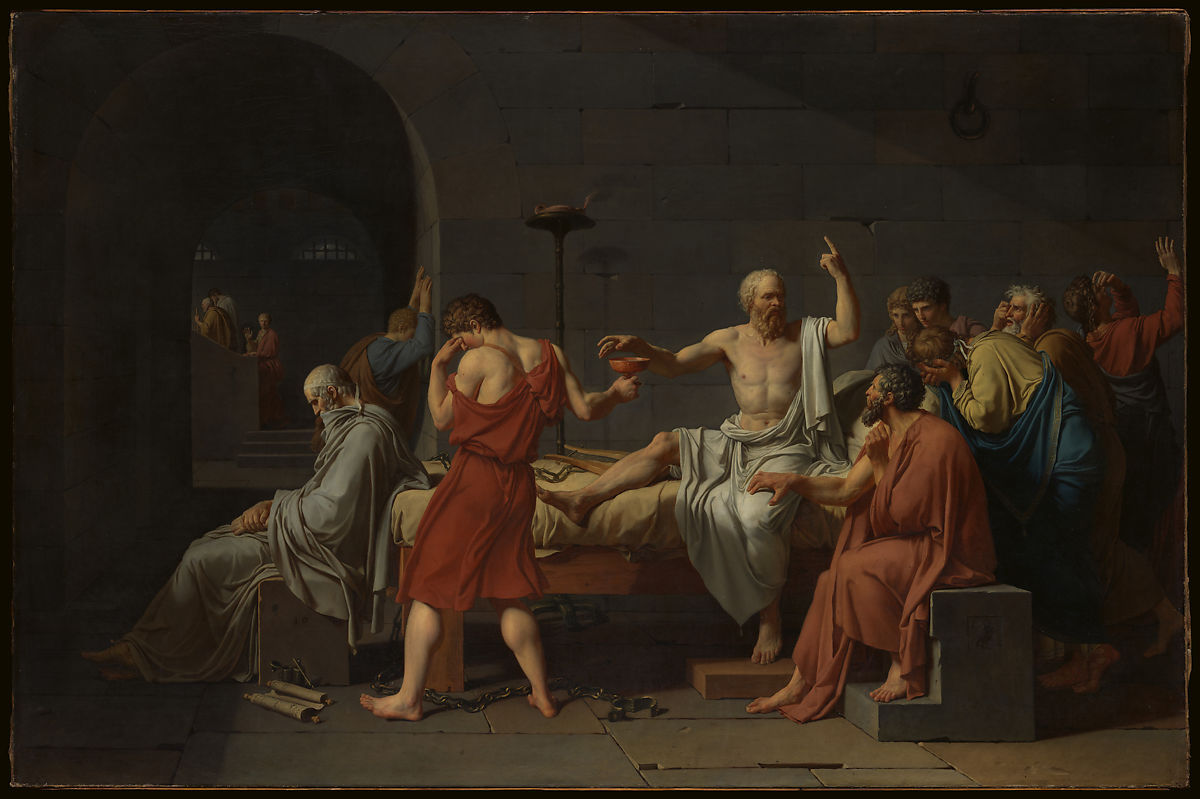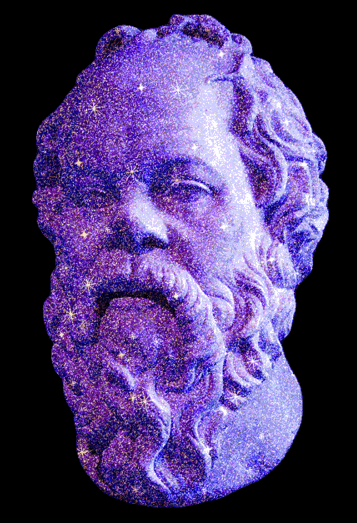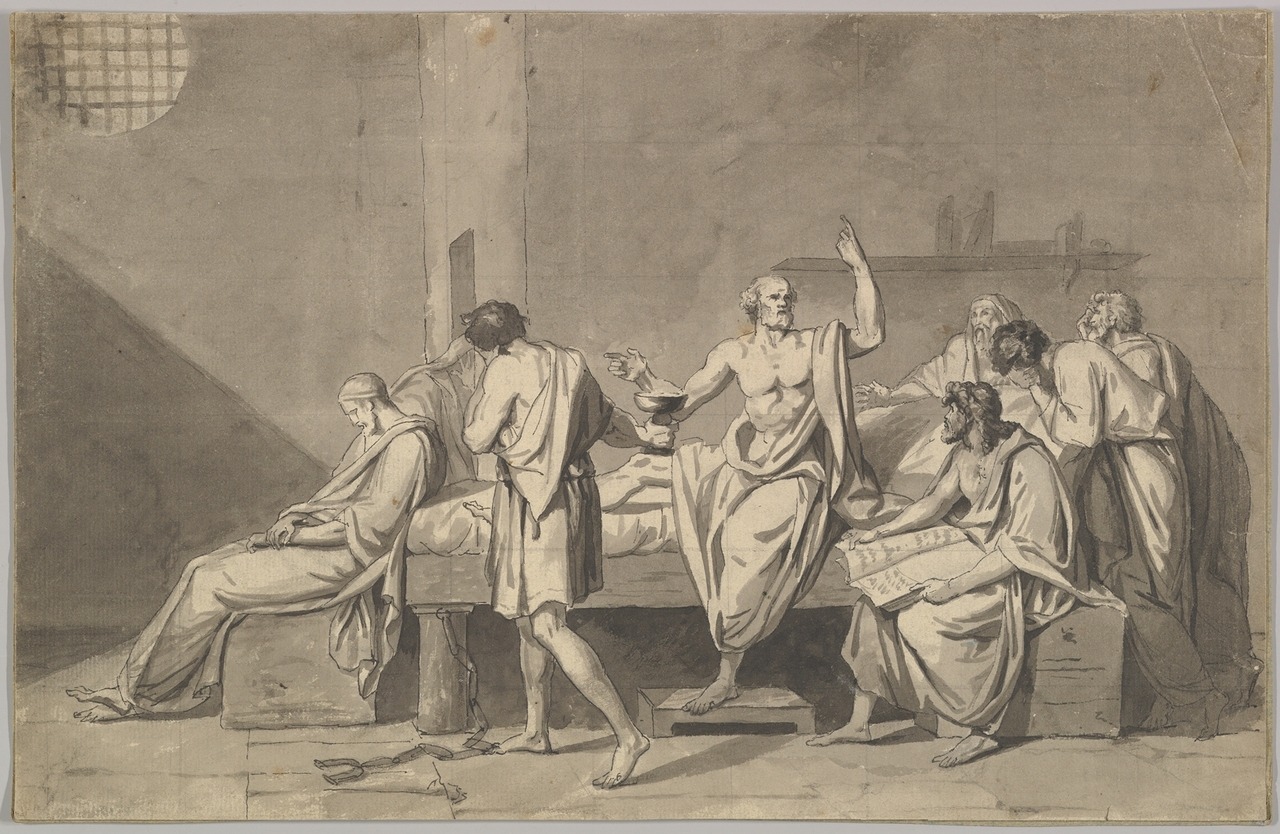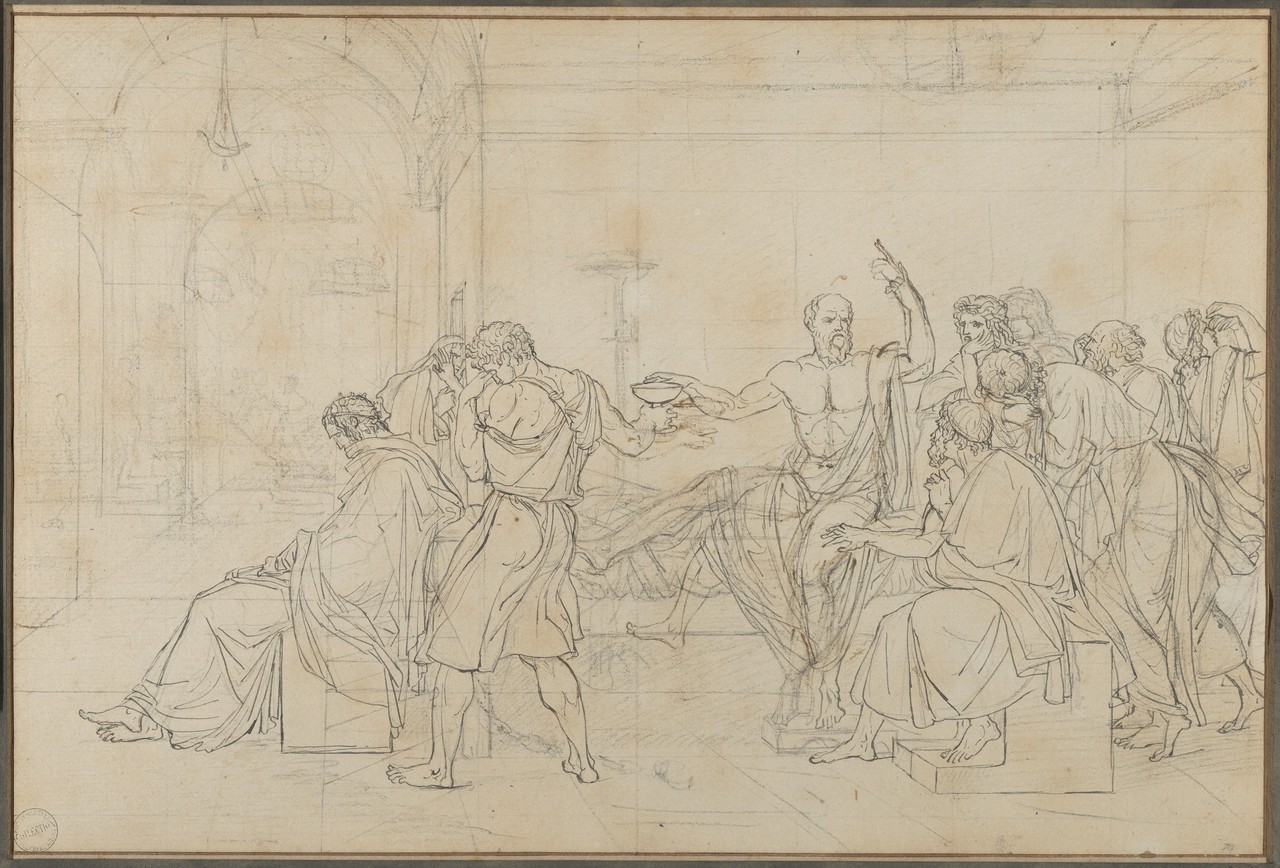Jacques Louis David
(French, Paris 1748–1825 Brussels)
La Mort de Socrate

The Death of Socrates
1787
1787
The Athenian courts executed the Greek philosopher Socrates (469–399
B.C.) for the crime of impiety: his behavior toward the gods was judged
to have been irreverent, and he had exerted a corrupting influence on
his young male followers. Socrates declined to renounce his beliefs and
died willingly, discoursing on the immortality of the soul before
drinking from the cup of poisonous hemlock. In a prison of unrelieved
severity, David depicted a frieze of carefully articulated figures in
antique costume acting out in the language of gesture the last moments
of the moral philosopher’s life. Because, shortly before the onset of
the French revolution, the painting gave expression to the principle of
resisting unjust authority, it is among David’s most important works.
The canvas is also his most perfect statement of the Neoclassical style.

The Death of Socrates (French: La Mort de Socrate) is an oil on canvas painted by French painter Jacques-Louis David
in 1787. The painting focuses on a classical subject like many of his
works from that decade, in this case the story of the execution of Socrates as told by Plato in his Phaedo.
In this story, Socrates has been convicted of corrupting the youth of
Athens and introducing strange gods, and has been sentenced to die by
drinking poison hemlock. Socrates uses his death as a final lesson for his pupils rather than fleeing when the opportunity arises, and faces it calmly. The Phaedo depicts the death of Socrates and is also Plato's fourth and last dialogue to detail the philosopher's final days, which is also detailed in Euthyphro, Apology, and Crito.
In the painting, an old man in a white robe sits upright on a
bed, one hand extended over a cup, the other gesturing in the air. He is
surrounded by other men of varying ages, most showing emotional
distress, unlike the stoic old man. The young man handing him the cup
looks the other way, with his face in his free hand. Another young man
clutches the thigh of the old man. An elderly man sits at the end of the
bed, slumped over and looking in his lap. To the left, other men are
seen through an arch set in the background wall.
Although he consulted Father Adry, a scholar on the subject, David's
depiction of Socrates death contains many historical inaccuracies. For
simplicity, he removed many characters originally described in the
dialogues of Plato. However, he included Apollodorus,
the man leaning against the wall just within the arch, even though he
is said to have been sent away by Socrates for displaying too much
grief. David also misrepresented the ages of many of the pupils of
Socrates, including Plato. Plato would have been a young man at the time
of Socrates's death, but in this painting he is the old man sitting at
the foot of the bed. Even the face of Socrates is much more idealized
than the classical bust that is typically used as a reference portrait
of Socrates.
David uses color to highlight the emotion in this painting. The
shades of red are more muted on the edges of the painting and become
more vibrant in the center, culminating in the dark red robe of the man
holding the cup of poison, generally taken as offering the cup to
Socrates rather than receiving it after Socrates had consumed its
contents. The only two serene men, Socrates and Plato, are garbed in a
contrasting bluish-white. The more muted color scheme of this painting
may be a response to critics of David's Oath of the Horatii, who called his colors "garish".
David signed this painting in two places; he put his full signature under Crito,
the young man clutching Socrates's thigh, and his initials under Plato.
David's signature placement often had symbolic meaning – for example,
in his painting of Stanisław Kostka Potocki, David signed in the collar of the dog that is barking at the sitter. In Death of Socrates,
his signatures also have meaning. His initials under Plato are a
reference to the fact that the story comes from Plato, a thanks for the
inspiration. His fuller signature under Crito means that this is the
character whom the artist identifies most with. This may be a reference
for Crito's position in the composition – clutching Socrates's thigh. In
this way, David would be seen as a man who likewise clutches at the
morals and values that Socrates represents.
There is some controversy as to the origins of the painting. Vidal states that "the younger of Trudaine de Montigny's two sons commissioned David's Death of Socrates in 1786",
but Bordes says that "the drawing for Socrates…bears the unexpected
date of 1782." However, it is possible that the commission in 1786 was
for a painting that David had already conceived as early as 1782, and
Bordes does acknowledge that the date is an addition to the drawing. Regardless of when it was originally conceived, the painting was completed in 1787, in Paris.
It was during David's first trip to Rome
that he began to study the depiction of funerary scenes and to draw
many examples. Many of David's major works stem from these funerary
drawings.
In this painting, David examines a philosopher's approach to death.
Socrates is stoic and calm because he sees death as a separate, actual
realm, a different state of being from life but not an end to being. In fact, in Phaedo, Socrates seems more concerned with how Crito will handle his death than with his own well-being.
In the painting, Socrates's gesture shows us that he is still teaching,
even in the moment before his death. It is said that this gesture was
inspired by the poet André Chénier.

The Death of Socrates
Analysis
Analysis
Socrates. Put to death for corrupting the youth of Athens.
Socrates is considered one of the founders of Western Philosophy, and the inventor of the Socratic Method which is still widely used in classrooms today. He's something of a mystery, though, because what we know of him comes from second-hand accounts.
What?! It's true, the great teacher left behind no writings of his own.
Socrates is considered one of the founders of Western Philosophy, and the inventor of the Socratic Method which is still widely used in classrooms today. He's something of a mystery, though, because what we know of him comes from second-hand accounts.
What?! It's true, the great teacher left behind no writings of his own.

The Death of Socrates
Medium: Pen and black ink, with brush and gray wash over black chalk, with light squaring in black chalk
Dimensions: Sheet: 9 5/8 × 14 7/8 in. (24.4 × 37.8 cm)
Dimensions: Sheet: 9 5/8 × 14 7/8 in. (24.4 × 37.8 cm)
This sheet is an early exploration of the subject that Jacques Louis David would later treat in his 1787 painting, The Death of Socrates 31.45,
which entered the Met’s collection in 1931. It is essentially a tracing
or re-drawing of a looser sketch in a private collection
(Rosenberg-Prat, 2002, I, no.52, pp.71-72) which bears a date of 1782.
The composition of these two early treatments features the ancient Greek
philosopher Socrates in his prison cell, surrounded by disciples.
Sentenced to death by the Athenian courts for his unorthodox beliefs, he
prepares to drink from a cup of hemlock. His gesture heavenward
indicates that he has paused to expound upon his theory of the
immortality of the human soul.
David would return to the theme in 1786 when Charles-Louis Trudaine de Montigny, a wealthy conseiller in the Paris parliament, commissioned from him a painting on the subject. At that point, he made a quickly executed composition sketch, also in the museum’s collection (2015.149), incorporating various new ideas. In the later drawing, he has added recession with an arched passageway leading to a set of stairs on the left and supplemented the number of disciples on the right.
David would return to the theme in 1786 when Charles-Louis Trudaine de Montigny, a wealthy conseiller in the Paris parliament, commissioned from him a painting on the subject. At that point, he made a quickly executed composition sketch, also in the museum’s collection (2015.149), incorporating various new ideas. In the later drawing, he has added recession with an arched passageway leading to a set of stairs on the left and supplemented the number of disciples on the right.

These
works are characteristic of David’s elaborate method of preparing his
major canvases. He typically progressed from sketches to numerous more
finished compositional studies, introducing small changes and
refinements with each iteration. Only when the composition was fairly
resolved would he begin making studies for individual figures. The
museum’s collection also includes a drapery study for Crito (61.161.1), the disciple seated on the block to the right.
(Perrin Stein, July 2017)
(Perrin Stein, July 2017)

"If you have a good wife, you'll be happy, if you have a bad wife, you'll be a philosopher"
Socrates:
Best inspirational quotes, very useful for philosophy, ethics and essay quotes
To Download Environment PDF slides click here : https://imojo.in/33wucm (PDF slides of all the environment videos, 700 slides)

Socrates:
Biography of a Great Thinker
Socrates was one of the founders of Western Philosophy. He is credited with inventing a new form of discourse, the Socratic Method, which revolutionized teaching and is still widely used today. His methods won him few fans, however, and ultimately he was charged with corrupting the youth of Athens and was put to death.
Learn more about the mysterious man who taught Plato and so many others. As Isaac Newton said, "If I have seen further it is by standing on the shoulders of giants."
Our Great Thinkers playlist celebrates influential thinkers who have changed the world for the better.
Learn more about the mysterious man who taught Plato and so many others. As Isaac Newton said, "If I have seen further it is by standing on the shoulders of giants."
Our Great Thinkers playlist celebrates influential thinkers who have changed the world for the better.


No comments:
Post a Comment